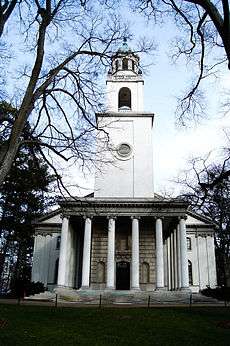Yerkes National Primate Research Center
The Yerkes National Primate Research Center in Atlanta, Georgia, is one of seven national primate research centers funded by the National Institutes of Health. It is known for its biomedical and behavioral studies with nonhuman primates.
Its 25-acre (10 ha) "Main Station" contains most of the center's biomedical research laboratories. The center also includes the 117-acre (47 ha) Yerkes Field Station near Lawrenceville, Georgia.
History
The center was established in 1930 by Robert Yerkes, in Orange Park, Florida, associated then with Yale University. Yerkes was a pioneering primatologist who specialized in comparative psychology.
In 1965 it relocated to its present location at 954 Gatewood Rd NE, Atlanta, Georgia, on the campus of Emory University.[1]
Satellite locations
The "Field Station" houses 3,400 animals, specializes in behavioral studies of primate social groups, and is located 30 miles (50 km) northeast of Atlanta, on 117 acres (473,000 m²) of wooded land, at 2409 Collins Hill Road, Lawrenceville, Georgia.
The "Living Links Center" is a part of the Yerkes National Primate Research Center run by primatologist Frans De Waal.[2] Located at the Yerkes Main Station on the Emory Campus, it also does work at the Yerkes Field Station.
Research
Multidisciplinary medical research at the Yerkes research center is primarily aimed at development of vaccines and medical treatments. Research programs include cognitive development and decline, childhood visual defects, organ transplantation, the behavioral effects of hormone replacement therapy and social behaviors of primates. Yerkes researchers also are leading programs to better understand the aging process, pioneer organ transplant procedures and provide safer drugs to organ transplant recipients, determine the behavioral effects of hormone replacement therapy, prevent early onset vision disorders and shed light on human behavioral evolution. Researchers have had success creating transgenic rhesus macaque monkeys with Huntington's disease and hope to breed a second generation of macaques with the genetic disorder.[3]
Controversy
Yerkes has long been the target of protest for its treatment of animals. This was especially true after the release of Frederick Wiseman's 1974 film Primate, which was shot at Yerkes and which depicted primates undergoing surgical procedures, as well as a transcardial perfusion and brain extraction.
Yerkes' proposal to do AIDS-related research on endangered sooty mangabey monkeys drew opposition from numerous primatologists, including Jane Goodall.[4] In 2007 Yerkes was fined for unsanitary conditions and poor procedures leading to the death of a macaque monkey.
Yerkes Center research assistant Elizabeth Griffin[5][6] became the first work-related death (December 10, 1997) in the center's history, due to herpes B virus.[7] Griffin apparently became infected after a fluid exposure to the eye which occurred while helping to move a caged rhesus macaque at the Yerkes Field Station, in Gwinnett County, Georgia. OSHA, the Occupational Safety and Health Administration, ultimately fined the center $105,300 in 1998, after a 19-week investigation(OSHA).[8] The event lead to reforms in safety protocols for handling research primates.
On June 15, 2011, at the Yerkes National Primate Research Center Field Station, in Gwinnett County, Georgia, personnel determined that Ep13, a non-infected female rhesus macaque, was missing.[9][10] On August 16, 2011, the search for Ep13 ended.
Directors
| Name | From | To |
|---|---|---|
| Robert Yerkes | 1930 | 1941 |
| Karl Lashley | 1941 | 1955 |
| Henry Wieghorst Nissen[11] | 1955 | 1958 |
| Arthur J. Riopelle | 1959 | ? |
| Geoffrey Bourne | 1962 | 1978 |
| Frederick (Fred) A. King[12] | 1978 | 1994 |
| Thomas R. Insel[13] (now director of NIMH) | 1994 | 1999 |
| Thomas P Gordon[14] | 1999 | 2002 |
| Stuart Zola[15] | 2002 | present |
See also
- California National Primate Research Center
- Oregon National Primate Research Center
- The Mind of an Ape
- Herpes B Virus
- Yerkish
Notes
- ↑ http://www.yerkes.emory.edu/
- ↑ Living Links Center. Emory University.
- ↑ Palmer, Jason (27 May 2009). "Glowing monkeys 'to aid research". BBC News.
- ↑ "Goodall opposes AIDS research on monkeys: Primate expert urges government to reject use of endangered animals". Associated Press. 22 June 2006.
- ↑ http://www.ergriffinresearch.org/about-elizabeth/
- ↑ A Drop of Virus From a Monkey Kills a Researcher in 6 Weeks, By RICK BRAGG, New York Times, December 14, 1997
- ↑ http://www.emory.edu/EMORY_REPORT/erarchive/1998/January/erjanuary.12/1_12_98Yerkes.html
- ↑ http://www.emory.edu/EMORY_REPORT/erarchive/ 1998/May/ermay.4/5_4_98Yerkes.html
- ↑ http://www.yerkes.emory.edu/about/news/rhesus_062311.html.
- ↑ http://www.ajc. com/news/calls-come-in-about-985776.html
- ↑ "Portraits of Pioneer in Psychology Volume III" by Donald A. Dewsbury
- ↑ "A Plea For the Chimps". The New York Times. 1987-06-21. Retrieved 2008-02-29.
- ↑ "Thomas R. Insel reflects on his first year as director of the primate research center". Emory Magazine. 1995. Retrieved 2008-02-29.
- ↑ "Insel leaves Yerkes post to head neuroscience center".
- ↑ "Stuart Zola Brings Passion and Candor to his Role as Director of the Yerkes National Primate Research Center". Emory Magazine. 1995. Retrieved 2008-02-29.
External links
- Emory.edu - Yerkes National Primate Research Center (official homepage)
- Emory.edu - 'The Capuchin Library'
- All-Creatures.org - 'World Laboratory Animal Liberation Week (around April 24)...a national week of protests, media events, etc. at laboratories to stop testing and research on animals'
- IDAusa.org (pdf) - 'Experiments Conducted on Macaque Monkeys: Psychological Torment, Behavioral Research, Effects of Nonmaternal restraint on vocalizations of infant rhesus monkeys (Macaca Mulata)', T. Jovanovich, H. Gouzoues, In Defence of Animals Report: Yerkes Institute
- PrimateFreedom.com - 'Life in a Laboratory', Primate Freedom Project
- EmoryLies.com - 'Supporting Excellence in Research', Primate Freedom Project

